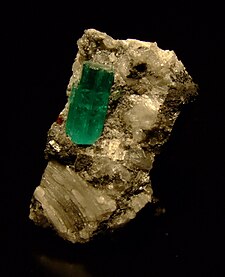| Message Us For More Info! |
|---|
|
This lovely Platinum ring is set with a centered brilliant Emerald surrounded by smaller Diamonds. Main Stone: Emerald Main Stone Weight: 0.32ct Secondary Stone: Diamond Secondary Stone Weight: 0.41ct Metal: Platinum Metal Weight: 5.70GR Metal Purity: 900 parts per 1000 Store Reference#: R10061

|
||||||||||||||||||
|---|---|---|---|---|---|---|---|---|---|---|---|---|---|---|---|---|---|---|
| Emerald | |
|---|---|

| |
| General | |
| Category | Beryl variety |
| Identification | |
| Color | Green shades to colorless |
| Crystal Habit | Massive to well Crystalline |
| Luster | Vitreous |
| Diaphaneity | Transparent to opaque |
Emerald
is a gemstone and a variety of the mineral beryl (Be3Al2(SiO3)6)
colored green by trace amounts of chromium and sometimes vanadium.[2]
Beryl has a hardness of 7.5?8 on the Mohs scale.[2] Most emeralds are
highly included,[3] so their toughness (resistance to breakage) is
classified as generally poor. Emerald is a cyclosilicate.
Etymology
The
word "emerald" is derived (via Old French: esmeraude and Middle
English: emeraude), from Vulgar Latin: esmaralda/esmaraldus, a variant
of Latin smaragdus, which originated in Ancient Greek: ?????????
(smaragdos; "green gem").[4]
Properties determining value

Color
Clarity

Emerald tends to have numerous inclusions and surface breaking fissures. Unlike diamond, where the loupe standard, i.e. 10× magnification, is used to grade clarity, emerald is graded by eye. Thus, if an emerald has no visible inclusions to the eye (assuming normal visual acuity) it is considered flawless. Stones that lack surface breaking fissures are extremely rare and therefore almost all emeralds are treated ("oiled", see below) to enhance the apparent clarity. The inclusions and fissures within an emerald are sometime described as "jardin" (French for 'garden'), because of their mossy appearance.[10] Imperfections are unique for each emerald and can be used to identify a particular stone. Eye-clean stones of a vivid primary green hue (as described above), with no more than 15% of any secondary hue or combination (either blue or yellow) of a medium-dark tone, command the highest prices.[6] The relative non-uniformity motivates the cutting of emeralds in cabochon form, rather than faceted shapes. Faceted emeralds are most commonly given an oval cut, or the signature emerald cut, a rectangular cut with facets around the top edge.
